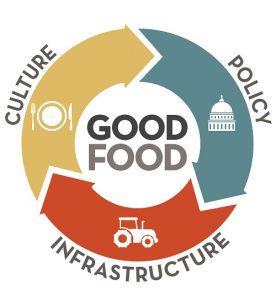Investing to Strengthen the Good Food Supply Chain
As Americans’ desire for healthier, more sustainable food options increases, the good food marketplace is rapidly maturing, creating opportunities for investors to drive social, environmental, and financial returns.
At Arabella, we believe the recipe for a Good Food system has three essential ingredients:
- A culture that demands good food
- An infrastructure that supplies good food to meet that demand
- A policy environment that enables a good food system to take root
Developing the infrastructure to supply good food will require more than philanthropy alone can deliver. Most of the solutions we need must come from private-sector commitments—specifically, from investments in companies across the food supply chain that can bring more sustainable, healthy, and affordable food to market.
Already, entrepreneurs and innovators are hard at work developing solutions designed to meet the good food market demands of the future. Below, we identify current opportunities across five areas of the good food supply chain—places where we believe capital investments can yield both compelling investment returns and meaningful impact in expanding the supply of good food. We’ve also packaged these opportunities into a platform we’re calling “On the Road to Good Food,” and in a brief report, “Investing to Strengthen the Good Food Supply Chain.”
Sustainable Agriculture
 Today’s agriculture too often uses synthetic chemicals and industrial products that compromise soil fertility, biodiversity, and food’s nutritional benefits. Currently, 38 percent of arable land worldwide is degraded by poor natural resource management. Investing in sustainably managed farmland can help drive a shift toward more holistic and regenerative approaches to food production, even as it produces strong financial returns.
Today’s agriculture too often uses synthetic chemicals and industrial products that compromise soil fertility, biodiversity, and food’s nutritional benefits. Currently, 38 percent of arable land worldwide is degraded by poor natural resource management. Investing in sustainably managed farmland can help drive a shift toward more holistic and regenerative approaches to food production, even as it produces strong financial returns.
Investment Opportunities:
- Organic Farmland: As an investment, domestic farmland has appreciated approximately five percent annually for the past decade. The stability and strength of farmland investing, coupled with skyrocketing demand for organic produce, have accelerated the growth of new organic farms and the conversion of existing farms to organic. Capital infusions by impact investors can bring economies of scale to organic farming, creating better incentives for restorative farming practices. Alternatively, they can provide concessionary capital to create a cushion as farmers convert to organic farming.
- Sustainable Livestock: Demand for sustainably raised livestock in the United States is rising exponentially, as organic, grass-fed, and pasture-raised livestock tends to be more nutritious, humane, and environmentally friendly. By supporting farms committed to sustainable livestock production, impact investors can help shift the market and bring scale to these businesses. Specifically, we see opportunities for investments in early-stage organic and sustainable meat companies and sustainable livestock ranches.
Sustainable Seafood
Advances in fishing techniques and rising consumer demand now seriously threaten seafood supplies. Approximately 70 percent of the world’s fisheries are exploited, overexploited, or have already collapsed. Scaling sustainable seafood practices will enable us to replenish our seafood supplies, improve health and diversity in seafood, and protect marine ecosystems. So far, the transition to sustainable fisheries has been supported primarily by philanthropists and the public sector, but we believe the rate and scale of transition needed requires an infusion of private-sector capital with a long-term return timeline.
Investment Opportunities:
- Sustainable Aquaculture Infrastructure: Over 90 percent of seafood consumed in the United States is imported from other countries, where fishing standards may be lax or nonexistent, and transportation creates a serious environmental issue. As Americans increasingly consider the source and quality of their seafood, not to mention the health of the world’s oceans and waterways, local and sustainable fish farming is becoming more popular. Over half of the seafood now eaten in the United States is farmed through aquaculture, and the numbers continue to increase. Sustainable aquaculture creates environmentally neutral and healthy seafood that can help support rising demand for healthy protein sources. We see an opportunity for impact investors to provide long-term equity or debt capital to support large capital investments in recirculating aquaculture systems that enable land-based fish farming in areas much closer to urban centers or geographies where traditional aquaculture would be impossible.
Healthy Food
Current crop and protein production too often delivers unhealthy food options for consumers. Without convenient and affordable access to good food, Americans often rely  on substitutes that are far less nutritious. This contributes to disastrous health issues, including the epidemic that has left one in three American adults obese. Consumers’ tastes are changing. Demand for organic products jumped 11 percent in 2015 and now accounts for $39 billion, or five percent of total US food sales. Meanwhile, innovators continue to pursue new technologies with the potential to disrupt the food sector.
on substitutes that are far less nutritious. This contributes to disastrous health issues, including the epidemic that has left one in three American adults obese. Consumers’ tastes are changing. Demand for organic products jumped 11 percent in 2015 and now accounts for $39 billion, or five percent of total US food sales. Meanwhile, innovators continue to pursue new technologies with the potential to disrupt the food sector.
Investment Opportunities:
- Natural and Organic Snacks: Changing consumer tastes and health goals are driving more healthy products in the $124 billion a year US snack food industry. Equity investments in healthy snacks—especially those that create convenient alternatives to traditional snacks—are increasing in popularity. The volume of investment opportunities in this sector is high, so impact investors will need to match their impact needs and investment profiles with the different types of opportunities available.
- Food Preparation and Delivery: In 2015, online grocery and delivery services took in over $1 billion in investments. These include prepared meal delivery and meal-kit delivery services, which are expected to grow exponentially in the next decade. While this sector has already seen significant cash flow and big name entrants, finding a successful business model has proven difficult. As companies seek innovative paths to profitability, we see opportunities for investors to make early-stage equity investments in companies that will help build out the supply chain and achieve economies of scale.
Access and Equity
Access to good food is a serious problem in the United States. The lack of healthy, fresh, affordable, and convenient food options has led to 48 million Americans living in food-insecure households. Another 23.5 million people live in so-called “food deserts,” where access to affordable and healthy food options is limited or nonexistent. While much of the change in food consumerism must be driven by education and awareness, there are business opportunities that specifically address these issues of convenience and access.
Investment Opportunities:
- Grocery Stores in Food Deserts: People who live in food deserts consume more fat, sugar, and cholesterol and less nutritious, fresh, and healthy foods than their fellow citizens. Recently, a class of impact-focused retail grocery stores and cooperatives has come onto the market. We see opportunities for impact investors to make equity and debt investments in these impact-first grocery alternatives, either to begin operations at the local community level or to expand and scale across the country.
- Urban Farms: Small-scale urban agriculture creates hyperlocal, sustainable food sources that decrease the environmental impact of food, reduce the time and number of intermediaries between farms and the consumer, and create greater urban food security. Impact investors interested in advancing resiliency and access to food in urban areas should consider early-stage debt and equity investments in these urban farms.
Food Waste
Roughly 40 percent of all food produced in the United States is wasted. About 30 percent of consumable produce never makes it into retail stores due to cosmetic standards. Often, this “ugly produce” is plowed back into the ground or sent to landfills, creating additional food waste and hurting farmers’ already thin profit margins.

Meanwhile, 33 million tons of food end up in landfills every year, driving $1.3 billion in disposal costs and creating methane, a potent greenhouse gas. In the last few years, multiple stakeholders have brought significant attention to this issue: The USDA and EPA set out the nation’s first food waste reduction goals; foundations and the private sector are increasingly committing investment capital; and grocery stores, restaurants, and consumers are more aware than ever of the impact of food waste. Investors can capitalize on these trends.
Investment Opportunities:
- Ugly Produce: The European Union has abandoned many produce specification rules, allowing supermarkets to bring “ugly produce” to market, and early efforts to replicate such efforts in the United States are encouraging. Investments in the ugly produce movement can help deliver cheaper fresh produce for consumers, increase profits for farmers, and lower environmental impact by keeping this potential food waste out of landfills.
- Recovery Infrastructure: Food recovery is the process of repurposing excess edible food, which can feed the hungry, increase profit margins for farmers and producers, and divert waste away from landfills. Opportunities are emerging to build a food recovery infrastructure, including technological platforms that match suppliers of excess food with food recovery agencies, transportation infrastructure for local and long-haul efforts that ship otherwise unwanted food to where it is needed, and value-add processing companies that convert excess food into products with longer shelf lives.
- Food Waste Recyclers: Facilities that recycle food waste can turn food that would otherwise clog landfills into useful products. Centralized anaerobic digestion facilities use microbes to naturally break down food into liquid digestate, solid digestate, and biogas. The liquid digestate can be used as a liquid fertilizer, and the solid digestate can be composted. The biogas byproduct can be used as natural gas. Impact investors with long-term capital can create meaningful change in food recycling by investing in centralized anaerobic digestion facilities that help the environment even as they create potentially profitable recycle streams.
Investment Pipeline
Arabella’s commitment to building a better food system—and our ongoing work with policymakers, entrepreneurs, investors, and philanthropists—has afforded us insight into the rapidly developing good food supply chain. As we continue to monitor the investment landscape, we are very excited by the volume and diversity of direct investment deals that are emerging, and the potential for both social and financial returns. We look forward to hearing from and speaking with our clients and other partners about these opportunities for impact.
Please email us at goodfood@arabellaadvisors.com to learn more about specific investment opportunities that work to build a good food system that provides access to healthy, sustainable, and affordable food for all.
Click here to download a copy of this report.
